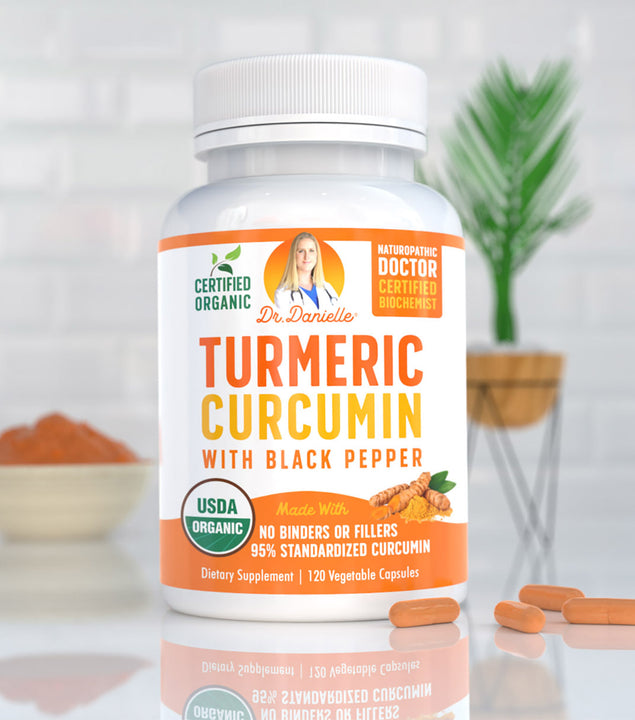A slow, silent disturbance that simmers in your body. You can’t feel it; you can’t see it – but it’s there and carries the potential of assaulting your healthy body cells and damaging internal organs. Eventually, paving the way toward numerous heavy-hitting illnesses such as cancer, heart disease, diabetes, and depression. Do you know what “it” refers to? Well, okay, so the title of this article is a dead giveaway. “It” is none other than chronic inflammation.
But … what is chronic inflammation, exactly? What causes it? And, if you’re indeed harboring this “silent killer” in your body, is that it, game over? Or are there steps you can take to fight it? Find out in this article.
What’s chronic inflammation? Why is it bad?

The “inflammation” you’re familiar with likely takes the form of a painful, sprained ankle post-fall or a sore-to-the-touch, angry-looking pimple on your face. While you're (somewhat) on the right track, what you're thinking of isn't chronic inflammation – but something called acute inflammation. To understand the difference between the two, it'll help if you first get some background knowledge on why your body gets inflamed in the first place.
Inflammation is entirely normal (1, 2, 3). When you are injured (e.g., scraped your knee) or sick (e.g., down with the cold), your body triggers an inflammatory response that allows your immune system to come into the picture, where hordes of white blood cells attack harmful and foreign "invaders". This kickstarts the healing process.
But here comes the catch. What you’ve just read describes acute inflammation, where your body gets inflamed, fights the offending infection, and heals. On the other hand, chronic inflammation happens when your body triggers an unnecessary, long-lasting immune response. These “misguided” white blood cells could then end up damaging healthy areas of the body.
Left untreated, chronic inflammation can lead to atherosclerosis (i.e., plaque build-up in arteries), periodontal disease, rheumatoid arthritis, inflammatory bowel disease, and even symptoms of diabetes! More scary still: this 2019 article published in Nature Medicine found chronic inflammatory diseases (e.g., ischemic heart disease, stroke, cancer, and non-alcoholic fatty liver disease) to be the most significant global cause of death – accounting for more than 50% of all deaths (4).
Causes of chronic inflammation
Honestly? Scientists are still in the process of decoding the exact causes of chronic inflammation (5, 6, 7, 8, 9). Still, they have discovered a few "culprits", including autoimmune disorders (e.g., Graves disease, Multiple Sclerosis, and type 1 diabetes) and long-term exposure to irritants like polluted air or industrial chemicals. Experts also believe that a range of lifestyle factors could increase an individual’s risk of chronic inflammation. This includes obesity, smoking, chronic stress, alcohol abuse, and a diet rich in saturated fats and added sugar.
How to combat chronic inflammation

Although scientific exploration on the causes of chronic inflammation remains in the early stages, the great thing is research shows that you have the power to prevent or reduce chronic inflammation. Here’s how.
#1: Build your diet around anti-inflammatory foods
Impressively enough, some experts say that adjusting your diet could be a better route to lowering inflammation levels than relying on medication (10). But how should you go about tweaking the foods you eat? Well, you could start by adding more "anti-inflammatory" foods into your diet. "Anti-inflammatory" foods are typically those rich in antioxidants, and omega-3 fatty acids – which means increasing your intake of fruits, vegetables, and fatty fish (e.g., salmon, sardines, and herring) is a great idea (11, 12, 13, 14, 15). There is also evidence that certain herbs and spices, like turmeric, ginger, and garlic, can help alleviate inflammation (16, 17, 18).
Think it'll be a challenge finding these "anti-inflammatory" foods at your favorite takeaway joint? Or maybe they're too expensive? Try meal prepping! You don't have to do it every day. Even just twice or thrice a week is better than not getting any “anti-inflammatory” foods into your system at all. Plus, you could always choose to boost your inflammation-fighting efforts with Dr. Danielle’s Turmeric Curcumin and/or Alpha Lipoic Acid. Like turmeric, alpha lipoic acid has strong antioxidant properties, which could help reduce inflammation (19).
#2: Take care of your gut health
Have you ever heard of something called “leaky gut syndrome”? If you haven’t, here’s the short of it. There is always some level of permeability in your gastrointestinal membrane to allow for the flow of water, nutrients (e.g., amino acids), and electrolytes into the bloodstream. That's fine. But what's not okay is when the “bad” bacteria in your gut overwhelm the “good”.
This causes the intestinal lining to become more permeable – allowing the likes of undigested food particles and other foreign invaders – to escape the gut and enter the bloodstream, where they can trigger an immune response in the body (20, 21). Causing? That’s right: widespread inflammation. To prevent this from happening, naturally, you’d want to promote healthy bacteria in your gut. Beyond simply adding antioxidant- and omega-3 fatty acids- rich foods into your diet (as mentioned in tip #1), you could also consider eating foods that contain probiotics and prebiotics (22, 23, 24). If you were wondering, probiotics are the actual beneficial bacteria, while prebiotics is types of fiber that feed the "good" bacteria found in your gut.
Foods high in probiotics include yogurt, kefir, and various fermented foods – including sauerkraut, kimchi, and Gouda. As for prebiotics, you can typically find them in high-fiber foods such as fruits, vegetables, and whole grains. Can’t stand the taste of fermented foods? Dr. Danielle’s Daily Probiotics can help. Two pills a day, and you’re well on your way to optimizing your gut flora and microbiome. Oh, and obviously, you should also support the health of your gastrointestinal barrier with Dr. Danielle’s Gut Assist – so it becomes less “leaky” over time.
#3: Exercise, exercise, exercise
Want to beat inflammation? Then making time for exercise should be at the top of your to-do list. Consider this 2020 study published in the Journal of Applied Physiology, for instance (25). The researchers concluded that a group of 75-year-old men who were lifelong aerobic exercisers had inflammation profiles much closer to those of 25-year-old exercisers than to their healthy 75-year-old peers who did not exercise! In short: research tells us that lifelong exercise promotes an overall anti-inflammatory profile in the body.
But let's be honest for a second. Committing to and keeping up with a regular exercise program can be a real struggle. Well, here's a secret: exercise doesn't have to be a bore! There are plenty of fun activities you could do that'll get your heart rate up – without you trudging on a treadmill or counting reps in the gym. Examples include hiking, rock climbing, dancing, martial arts, and yoga. You don’t always need to aim for a specific activity, either. Simply finding ways to move more throughout the day (e.g., fidgeting, playing with your pets, climbing the stairs) would count toward your “exercise meter”.
#4: Find ways to manage stress levels
In today’s achievement-oriented world, stress is celebrated. It’s seen as a good thing. Too much on your plate? Don’t have a moment to breathe? Good, you must have made it in life. But the constant stress is a crucial contributing factor to inflammation in the body (26). How come? First off: stress elevates your body’s production of cortisol (i.e., the “stress hormone”). Under normal circumstances, cortisol levels naturally decline as the stressor leaves or subsides. Now … imagine what happens when you’re stressed 24/7. That's right: cortisol levels remain elevated. And over time, your body becomes less sensitive to cortisol.
This is terrible news because cortisol regulates inflammation (in addition to the stress response). And when your body no longer responds "correctly" to cortisol? Inflammation gets out of control. So how do you fix this? Answer: by practicing stress management techniques. Before you retort with, “Where am I going to find the time for that?”, well, here's the thing. There are plenty of stress-relieving methods you could use that require minimal time.
A good example is breath work, where all you need to do is focus on your breath as you inhale and exhale through the nose for anywhere between 2 to 10 minutes (27, 28, 29). If you wish, you could even add a count to your breathing. For example, inhale for a count of five. Next, hold for a count of one. Then, exhale for a count of six. Continue till you feel better.
Oh, and let’s not forget about supplements, like ashwagandha (found in Dr. Danielle’s Stress Lift, by the way!), which could help you find your zen in the snap of a finger (30).
Don’t be afraid to reach out for medical advice
Concerned about your body’s current level of inflammation? It’s always a good idea to speak with your healthcare provider. While there are no real tests to diagnose “chronic inflammation” per se, your doctor can recommend certain blood tests as a starting point – like ones that highlight C-reactive protein (CRP), which indicates inflammation in the general body. Other than finding out your “inflammation status”, a blood test will also provide both you and your doctor a good sense if the lifestyle changes you’re making are helping (by doing a test again after some time).








